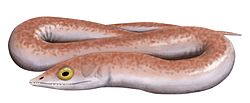Content of the group
Stem tetrapods are members of Tetrapodomorpha, the total group and clade that also includes their descendants, the crown tetrapods: [1]
The stem Tetrapoda encompass three distinct grades successively closer to crown group Tetrapoda: [2]
Both Ichthyostegalia and Labyrinthodontia constitute paraphyletic evolutionary grades rather than clades, with amniotes and modern amphibians branching off at some point from the latter. The stem tetrapods may also include one or both of Temnospondyli and Lepospondyli, depending on author. This is due to the uncertain origin of the modern amphibians, whose position in the phylogenetic tree dictates what lineages go in the crown group Tetrapoda. [3] [4] Neither is there for the moment a consensus of the phylogeny of stem tetrapods, nor how Tetrapoda itself should be defined (i.e. as a crown group, or as an apomorphy-based group, using the limb with digits), [5] making the actual content of the group uncertain. [6] [7] [8]
This page is based on this
Wikipedia article Text is available under the
CC BY-SA 4.0 license; additional terms may apply.
Images, videos and audio are available under their respective licenses.






